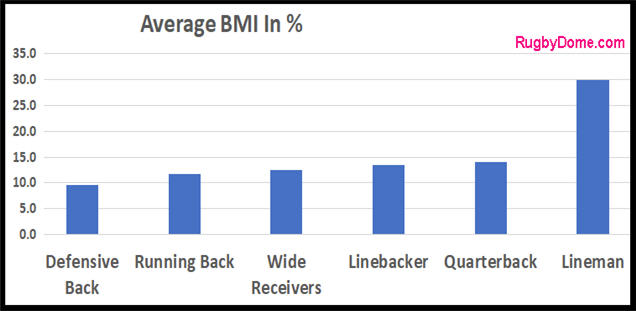The average weight of quarterbacks in the NFL is 225 lbs in recent years. Running back is the position nearest in size to the quarterback average.
Quarterbacks in college football have an average weight of 207 lbs.
How Do NFL Quarterbacks Compare To Other Positions?
Here is a graph of how the average weight of quarterbacks compares to the other positions:

As you can see, quarterbacks fall in the middle of the upper and lower range of positions on the field.
The raw data below shows that quarterbacks are 25 pounds heavier than defensive backs and wide receivers. But they are nearly ninety pounds lighter than offensive linemen.
| NFL | lbs |
| Offensive Line | 314 |
| Linebacker | 245 |
| Quarterback | 225 |
| Running Back | 214 |
| Wide Receiver | 200 |
| Defensive Back | 200 |
Other positions
If you want more details about the other positions, check out these in-depth articles:
- Average running back weights
- Average lineman weights
- Average linebacker weights
- Average wide receiver weights
- Average defensive back weights
Why Are Quarterbacks Heavier Than Running Backs And Wide Receivers?
One of the reasons that quarterbacks are heavier than the guys they are passing to is that they are usually taller.
Tall quarterbacks have an easier line of sight over the defense. Taller players should also be able to throw the ball longer.

Why Are Quarterbacks Lighter Than Linebackers And Offensive Linemen?
Quarterbacks are of slighter build than linebackers and offensive linemen.
Wouldn’t it be better if they bulked up to add a little more strength to their throw?
The reason quarterbacks stay leaner is to keep their speed and agility to avoid the rush.
How Do NFL Quarterbacks Compare To College Football?
College football players aren’t as heavy as professional NFL players, but they can still be pretty big.
The average weight of quarterbacks in college football is 207 lbs, which is eighteen pounds lighter when compared to the NFL.
That means college stars do have to pile on some weight as they approach their rookie season in the NFL.
However, it’s not as bad as other positions.
For example, Greg Ruegamer was a talented lineman at Arizona State who weighed 290 lbs in his senior year. The Miami Dolphins coach got on the phone to him on NFL draft day and asked him to add another 30 lbs to his bulk.
Quarterbacks aren’t under the same kind of pressure when transitioning into pro football.
How Do Quarterbacks Compare To The Average American Male?
The average American man weighs 196 lbs according to the CDC. That’s nearly thirty pounds lighter than the average professional quarterback.
But what about body fat percentage?
A study in 2013 found that quarterbacks have an average body fat percentage of just over 14%.
The average male in the United States has a percentage of about 28%, which is about twice that of quarterbacks.
That may not surprise you when you look at the likes of Tom Brady.
But how does this compare to the heaviest position in the NFL? Linemen clock in at nearly 30% body fat percentage.
This graph shows BMI across different positions:

History Of Average Weights Of Defensive Backs In The NFL
It’s difficult to compare weights through history as positions and roles have changed significantly.
But we’ll take a look at some of the greats of past decades.
Johnny “Golden Arm” Unitas weighed about 194 lbs when he was with the Colts through the 1960s.
Jumping to the 1970s, Roger Staubach of the Dallas Cowboys weighed about 197 lbs.
Joe Montana of the 49ers clocked in at 205 lbs in the 1980s.
So, all these guys have been light..but getting slightly heavier.
Brett Favre was significantly heavier at about 225 lbs through the 1990s. And that is bang on the current average.
Sure, we’ve given you a small sample. However, it seems that quarterbacks have slowly gotten heavier (or taller) through the past decades.
How Do Quarterbacks Compare To Other Sports?
Let’s take a look at heavyweights in boxing. Anthony Joshua weighs about 240 lbs, which is a stone heavier than the average quarterback.
But quarterbacks are a significant fifty-five pounds heavier than the 170 lbs average weight of soccer players recorded at the 2018 World Cup.
But it doesn’t make a whole lot of sense to compare NFL with soccer players. We should look at another contact sport.
Rugby is probably the closest sport to American football.
If you’re interested in football history, check out our article on whether American football evolved from rugby.
Weight of quarterbacks versus flyhalves
Of course, the positions and roles don’t line up easily when comparing the two games.
But we figure that flyhalves (the number ten) in rugby are the closest position to quarterbacks in football. We explain why in our article on who is the quarterback in rugby.
Here is a summary of average weight and height differences across professional football and Rugby Union.

Flyhalves in professional Rugby Union weigh an average of 197 lbs. That’s significantly lighter.
My reasoned guess as to why is that height is not a requirement for flyhalves. In our article on heights in rugby, we show that flyhalves average at six feet.
That is three inches shorter than the average across quarterbacks.